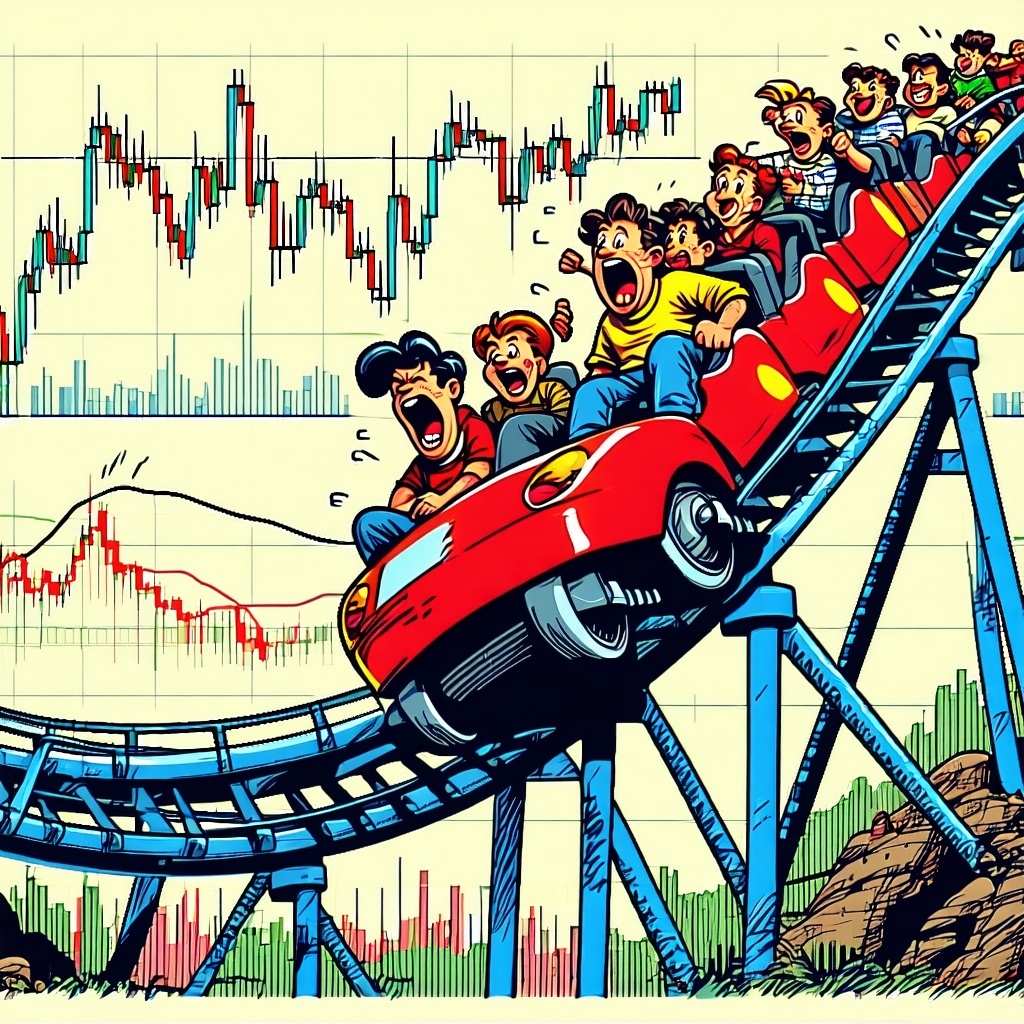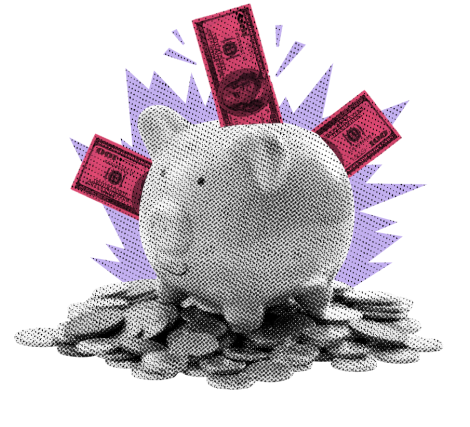
Want higher returns? You better love volatility.
KEY TAKEAWAYS
- Risk and reward are mathematically linked—no free lunch in investing
- CAPM says only systematic risk (measured by Beta) is rewarded
- Higher Beta = more volatility, more potential return—and more pain
- Diversification minimizes idiosyncratic risk but not market risk
- Recent volatility is driven by tariffs and systemic uncertainty
MY HOT TAKES
- CAPM isn’t just a classroom model—it explains your portfolio pain
- High-Beta stocks like NVIDIA aren’t broken—they’re behaving exactly as expected
- Even diversified portfolios can get hit hard when the whole market moves
- Most investors underestimate the real price of trying to “beat the market”
- You can’t escape volatility without giving up upside—there’s always a tradeoff
- You can quote me: “You risk extra-market losses to get extra-market returns.”
No free lunch. I am sure that you heard that, on Wall Street, there is no free lunch, and there isn’t. These last few months of eye-watering volatility have thrown that concept into sharp focus. What? You didn’t feel the volatility? Sure, you did. Your favorite tech stocks got whacked in the first few months of the year. In fact, the pain was not limited to just tech stocks, but rather it was all your growth stocks that have outperformed the markets in the past few years. I can say that with confidence without even knowing what stocks you own. Let’s dive in.
I am sure that your parents, siblings, or mentors taught you at a very young age that risk and reward are somehow, inexorably attached by some unknown, but very powerful universal force. “No risk, no reward.” So goes the saying, and that can be directly tied to the stock markets, mathematically even.
Let’s start with the Nobel Prize winning Capital Asset Pricing Model, or CAPM. CAPM states that a stock’s expected return depends only on its exposure to market risk, measured by Beta. Investors are rewarded for taking on systematic risk, not stock-specific risk, so only Beta — not total volatility — drives expected returns above the risk-free rate. Ok, I know that was a mouth full. First, systematic risk is the market-wide risk that affects all investments and cannot be eliminated through diversification. A simple way to think of that is how all ships fall with the ebbing tide. All ships! So, owning many of them will provide you no benefit as they will all go down.
Here is the CAPM equation:
E(Ri)=Rf+βi⋅(E(Rm)−Rf)
Where:
E(Ri) is the expected return for the stock
Rf is the risk-free rate of return. You can use a 3-month Treasury Bill yield for this.
βi is the stocks Beta (you can look this up on Yahoo! Finance), or how a stock moves relative to the market or index.
Rm is the return of the market or index
(E(Rm)−Rf) is the market risk premium
Let us think about Beta for a moment, because most of us know about it, at least at a high level. A Beta of 1 means that a stock will move in lockstep with the index, or market. Betas less than 1 mean that stocks will have less accentuated moves than the market, and conversely stocks with Betas greater than 1 will have more pronounced moves. Using the equation, we note that stocks with higher Betas are expected to have returns greater or less than the market, based on the actual Beta. So, Beta can be thought of as a stock's sensitivity to market movements, and if a stock is more sensitive, an investor would expect higher returns in compensation for taking on the additional volatility risk.
Now, even if I lost you on the math, you inherently know from experience that this, unfortunately works in both directions. When markets go down, higher Beta stocks decline more than the market. That is, kind-of, your risk. You risk extra-market losses to get extra-market returns.
Given a portfolio full of stocks with all different Betas, therefore, you can expect returns (OR LOSSES) based simply on the movements of the market multiplied by your weighted average Beta. You want to beat the market? Your weighted average Beta needs to be greater than 1. However, you now know that that comes with the risk of losing more than the market if it goes down. By how much? Exactly by your weighted average Beta.
That seems so simple, doesn’t it? It actually IS simple–it’s just math, silly. Now, here is where it gets a little dicey. While you can assume that high beta stocks are inherently risky, that is not technically consistent with CAPM. You see CAPM is based on observed behavior–how much has the stock moved relative to the market in the past–technically Beta. If it is high, you expect extra-market returns.
What do I mean by this? There is no nerdy analyst that analyzes a company and decides how risky it is and then assigns a Beta which increases with risk. Getting fuzzier yet, there is something known as idiosyncratic risk, which is company-specific risk that affects a single stock or asset and can be eliminated through diversification. An example of idiosyncratic risk is how Berkshire Hathaway’s stock fell by -4.8% yesterday after longtime, superstar investor CEO Warren Buffet stepped down unexpectedly over the weekend. That has nothing to do with Beta. In this case, if, unlike most people in Omaha, you owned more than just Berkshire Hathaway, diversification would have minimized that risk. That risk that something specific to one company can happen unexpectedly. HOWEVER, it turns out that markets declined yesterday. Therefore, your stocks, even if you were diversified, would have gone down by the market’s decline multiplied by your weighted average Beta. If one of those stocks were Berkshire Hathaway, you would have lost more, because of the additional idiosyncratic risk.
So, going back to the top where I asserted that your big winners from the last few years were your biggest source of pain recently. That pain did not come from company-specific risk, but rather market, or systematic risk. Take for example, NVIDIA which has a high Beta (2.11 according to Yahoo! Finance), it should have declined around twice as much as the market. If it declined more, it was because of company specific, or idiosyncratic risk, like surprise regulation or tariffs that were announced and expected to impact growth.
I will close with a chart that I crafted for you which shows all the Dow Jones Industrial Average Stocks plotted on a risk reward chart. Risk here is observed standard deviation annualized (volatility), and return is mean observed returns annualized. I added NVIDIA for reference (even though it is not in the Dow).

This chart shows the classic tradeoff: more risk, more reward. NVIDIA sits high and to the right, which is classic high-Beta behavior. It surges when markets run, tumbles when they trip, and throws in some extra chaos of its own (aka idiosyncratic risk). CAPM says that’s fair– if you're taking more systematic heat, you deserve a shot at a bigger payoff. JPMorgan, the calm in the storm, nails the best risk-adjusted return. The dashed line is the Sharpe line — it shows the best possible return per unit of risk, based on the market's top performer. Stocks sitting below that line? They're not pulling their weight — delivering less return than you'd expect for the risk you're taking.
Never mind the Sharpe line, what’s the bottom line? These past several months have caused volatility, largely driven by systemic risk and the market’s disapproval of the President’s sloppy tariff rollout. Recently, the President shifted into a negotiation phase which caused markets to breathe a sigh of relief–recent market rally. Now, based on what you know from today’s lecture 🤓, you know that we can expect more idiosyncratic risks to express themselves in your portfolio over the next several months, as we possibly experience surprise tariffs impacts on individual company earnings. Worried about that? You are right to be, but remember, diversification can minimize idiosyncratic risk. Markets? They will do what they will do, and you can’t control them, but if your portfolio is too jumpy for your taste, you should lower your weighted average Beta. But remember, if you do that, you lower your expected return–ouch. No risk… no reward, goes the old nugget. Investing isn’t easy.
YESTERDAY’S MARKETS
Stocks declined yesterday after the President threatened a hefty tariff on movies produced offshore. It was a wakeup call for markets that have attempted to put tariff pain behind it, celebrating with a 9-day run that abruptly ended yesterday. Bets on a June rate cut declined significantly in the wake of last week’s healthy jobs numbers; Fed Funds futures are now pointing to only 3 rate cuts before year end.

NEXT UP
- Trade Balance (March) may show that the deficit widened to -$137.2 billion from a surplus of $122.7, confirming tariff front loading in March..
- The Fed’s FOMC meeting starts today but mum’s the word until tomorrow when the fireworks show is scheduled.
- Important earnings today: Marathon Petroleum, Brookfield Asset Management, Zoetis, Ball Corp, Duke Energy, Datadog, Marriott International, Constellation Energy, Global Payments, Jacobs Solutions, Archer-Daniels-Midland, American Electric Power, DoorDash, Lucid Group, AMD, Rivian, Electronic Arts, Wynn Resorts, Serepta Therapeutics, Lumentum, Devon Energy, and Super Micro Computer.
.png)

